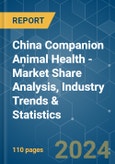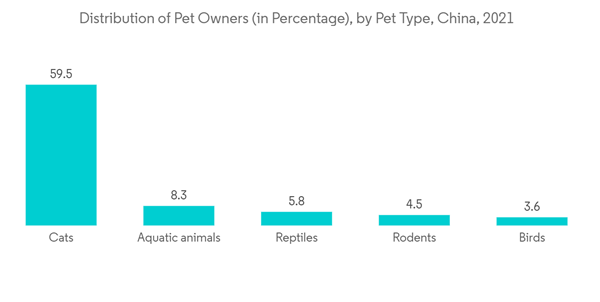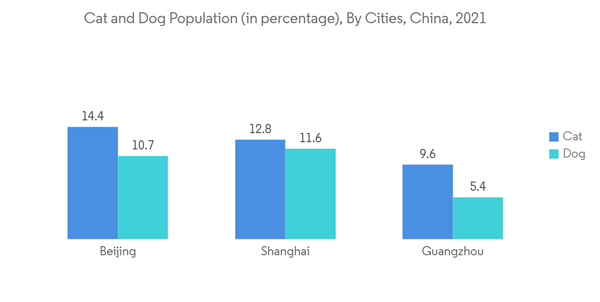The China companion animal health market size is expected to grow from USD 1.04 billion in 2024 to USD 1.2 billion by 2029, at a CAGR of 4.69% during the forecast period.
This product will be delivered within 2 business days.
Key Highlights
- Supply disruptions and shortages of veterinary medicines were observed in China, primarily due to the temporary lockdowns of manufacturing sites and increased demand for medicine to treat COVID-19. An article published in the Journal of Animals in July 2021 indicated that during the loc 2021 indicated that during the lockdown imposed on the COVID-19 pandemic, people were forced to leave their pets behind, significantly affecting the market's growth.
- Also, some organizations in China announced campaigns to kill any cats or dogs found outdoors to prevent disease transmission. Such activities affecting the lives of pet animals drastically affected the growth of the companion animal health market in the nation during the COVID-19 pandemic. However, the market has recovered, and demand for companion health services has increased as the number of pet adoptions increased during the pandemic. Moreover, the market is expected to grow to its full potential over the forecast period.
- The Chinese companion animal health market is primarily driven by the rising popularity of pet ownership, growing spending on animal healthcare, and rising awareness regarding the various treatments available for companion animal diseases.
- In recent years, there has been a significant increase in the adoption of dogs and cats in China, as they are the favorite companions of human beings. According to the article published in Sixth Tone in August 2022, there were more than 58 million pet cats in China in 2021, an increase of 19.4% from the previous year, while there were 54 million pet dogs in 2021. With the increase in the number of companion animals, owners are becoming increasingly aware of their pet's health and nutrition and are also seeking veterinary services. This, in turn, is creating a growing demand for companion animal healthcare products, thereby boosting the market growth.
- Furthermore, there are also increasing initiatives by the government and animal welfare associations to create awareness about the various diseases that affect companion animals, which will augment the growth of the market as awareness can prevent various animal-related diseases. For instance, in April 2022, "Empowering 10,000 China Pet Retailers" was an initiative that was started by the China International Pet Show (CIPS) to create awareness about companion animal medicines. By the end of 2022, the team had held 200 seminars, events, and training sessions in six different cities. This is expected to create awareness among pet retailers about companion medicine products, which are expected to drive the growth of the Chinese veterinary healthcare market. Additionally, rising public organization initiatives in China to educate people about the adoption of stray animals are expected to drive the growth of the Chinese veterinary healthcare market. For instance, in June 2021, Animal Rights Organisations in China opened a new welfare center to educate the public about animals and encourage the adoption of stray animals, even though no laws exist to protect them. This will further be expected to drive growth in taking care of stray animals, thereby boosting this market.
- In addition, the growing investments in the development of manufacturing plants for pet care products are also one of the key contributors to the growth of the Chinese companion animal health market. For instance, in February 2021, Delvigent opened its new feed additive plant in China. The first phase of the state-of-the-art factory has a capacity of 60,000 metric tonnes per year for the production of feed additives with short- and medium-chain fatty acids and essential oils as main components, with the possibility to expand to 120,000 metric tonnes of feed additives per year in the future.
- Thus, all the aforementioned factors, such as the growing adoption of pet animals and the launch of awareness initiatives and strategic activities by the market players, are expected to boost market growth over the forecast period. However, the availability of a considerable number of counterfeit animal products and drugs on the market, including several fakes or copied companion animal drugs, is identified as an obstruction to the growth of the Chinese companion animal health market.
China Companion Animal Health Market Trends
Vaccines Contributed the significant Market Share Share in Terms of Revenues in the Therapeutics Segment
- Vaccines are a crucial part of preventive healthcare for companion animals. They are categorized as core vaccines and non-core vaccines. Core vaccines are compulsory for all companion animals, whereas non-core vaccines are indicated by companion animal lifestyle or based on geographical area. In China, new advanced vaccines contain genetically engineered components derived from those disease agents. In dogs, rabies, distemper, hepatitis/adenovirus, parvovirus, and parainfluenza are the core vaccines, while Bordetella, leptospirosis, Lyme disease, giardia, and canine influenza H3N8 are the non-core vaccines. In cats, FVRCP (distemper) is the vaccine to protect against rhinotracheitis (feline herpes), calicivirus, and panleukopenia. Also, Rabies FeLV (feline leukemia) vaccines are given to cats.
- Rising public organization initiatives in China to educate people about adopting stray animals are expected to drive the growth of the China Veterinary Healthcare market. For instance, in June 2021, Animal rights organizations in China opened a new welfare center to educate the public about animals and encourage the adoption of stray animals, even though there are no laws to protect them. This will further drive growth in caring for homeless animals, boosting this market.
- Moreover, the vaccine segment is expected to be driven by vaccine innovations, growing awareness of animal health, increasing investments by government bodies and associations, and increased expenditure on the healthcare of companion animals. In September 2021, ACTAsia, a WSAVA Educational Partner, conducted rabies immunization clinics in Chinese villages. Further, growing research and development activities for developing animal vaccines are expected to propel the market's growth. For instance, in October 2022, Scientists in China rushed to create a vaccine for the most significant animal illness outbreak in history, the African Swine Flu. Scientists hope to have a pig vaccine ready for use by late 2024.
- Thus, the rising adoption of vaccines in treating animal diseases and product launches by market players are expected to boost the segment's growth.
Dogs Segment Hold Significant Share in the Market Over the Forecast Period
- Companion animals, such as dogs, provide companionship to human beings. The rising prevalence of diseases among animals and increasing companion animal ownership drive market growth.
- Dogs are becoming popular pet companions among the elderly population, and younger people who are childless or single think that dogs are a better option. The majority of Chinese households have pets, including dogs and cats. Pet owners are also becoming increasingly concerned about the food they feed their animals because some pet meals can lead to health allergies and impair their general health and fitness. According to the Global Pets Data published in February 2023, there were 112.3 million urban dogs in China in 2021, an 11.4% rise from the previous year. In China, dogs aged 1 to 5 years account for 50.3% of all dogs, while older dogs account for 37% and pups for 12.7%. Hence, the country's massive population of dogs and cats is expected to increase adoption, thereby boosting the segment's growth.
- Moreover, technological advancements in pet health, especially for dogs in China, are further expected to drive the segment's growth in China. For instance, in October 2021, JD Health expanded its telemedicine services to include dogs. JD Health and JD Pet had started "JD Pet Hospital," an O2O healthcare service platform that spans the entire lifespan of dogs, from disease prevention and diagnosis to comprehensive health management. The rising telehealth initiatives in veterinary health, especially for dogs and cats, are further expected to drive the growth of this segment in China.
- Furthermore, the growing number of dog and cat care product launches is expected to boost the segment's growth. For instance, in March 2022, ADM introduced Equilibrio, a new premium pet food brand, to the Chinese market. The company offers meals that target particular health concerns, such as hairball control and digestive wellness, for dogs of all sizes and life stages.
- Therefore, factors such as the increasing adoption of dogs and initiatives such as telehealth in veterinary medicine are expected to drive the growth of this segment in China.
China Companion Animal Health Industry Overview
The China companion animal health market is a consolidated market with few dominant players. The market players adopt various strategies such as product launches, mergers and acquisitions, and partnerships to stay competitive in the market. Key market players in the market include China Animal Husbandry Co. Ltd, Shenyang Dachang Medical Imaging Technology Co., Ltd., Elanco Animal Health, Merck & Co., Vetoquinol SA, Virbac, and Zoetis Inc., among others.Additional Benefits:
- The market estimate (ME) sheet in Excel format
- 3 months of analyst support
This product will be delivered within 2 business days.
Table of Contents
1 INTRODUCTION
4 MARKET DYNAMICS
5 MARKET SEGMENTATION (Market Size by Value - in USD)
6 COMPETITIVE LANDSCAPE
Companies Mentioned (Partial List)
A selection of companies mentioned in this report includes, but is not limited to:
- China Animal Husbandry Co. Ltd
- Shenyang Dachang Medical Imaging Technology Co., Ltd.
- Elanco Animal Health
- Merck & Co.
- Vetoquinol SA
- Virbac
- Zoetis Inc.
- IDEXX Laboratories Inc.
- Ceva Santé Animale
- Pulike Biological Engineering
- Tianjin Ringpu Biotechnology Co. Ltd
Methodology

LOADING...










